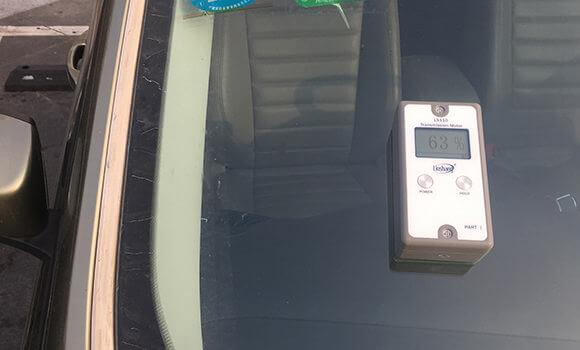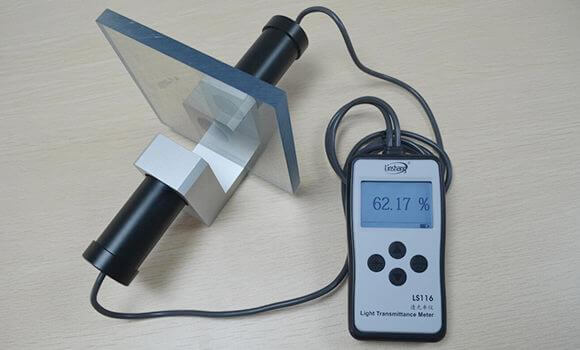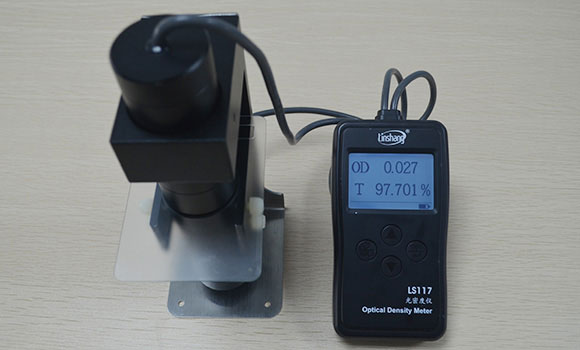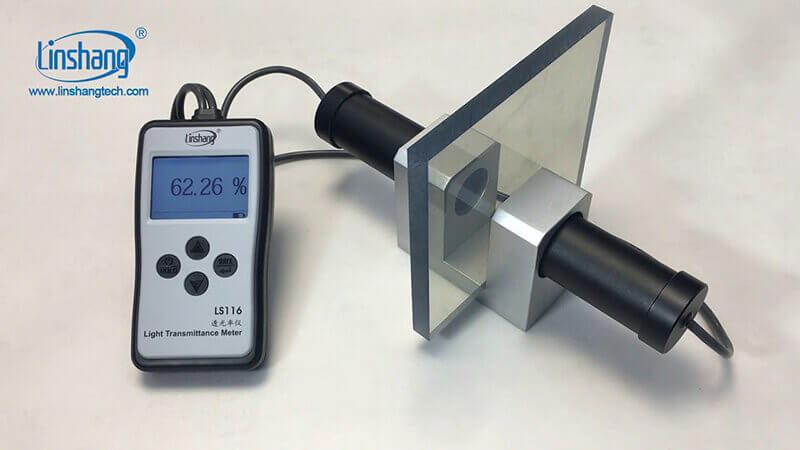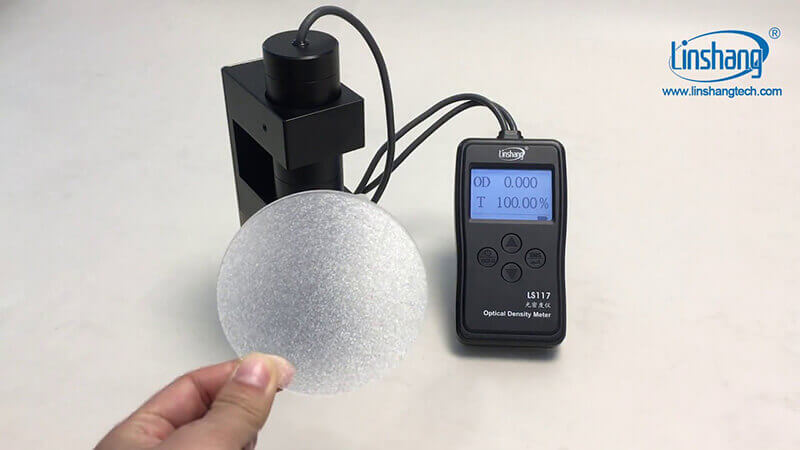How do Tint Meter Work and its application?
Light transmittance is an important indicator of many light-transmitting materials. Tint meters are used to test the visible light transmittance of transparent or translucent materials. Such as glass, solar film, organic materials and so on. There are many brands of tint meters on the market and their product models are also different.
Linshang Technology as a Chinese tint meter manufacturer invent three models tint meters respectively are LS110, LS116, LS117. The principle of these tint meters is to use a visible light source to illuminate the measured material. The sensor detects the incident light intensity of the light source and the light intensity after transmitting the measured substance, expressed as a percentage by the tint meter.
This article mainly introduces the tint meter for detecting visible light. If you also need to measure the transmittance of ultraviolet or infrared, check out other optical transmittance measuring instruments introduced at the end of the article.
I. Linshang tint meter
The tint meter is widely used in field measurement in automobile manufacturing and inspection, glass manufacturing, solar film, aerospace and other industries. The most representative testable materials in the industry are as follows:
| Plastic | Glass | Film |
| PC board | Frosted glass | ITO film |
| Transparent Acrylic Sheet | Car Windshield | Greenhouse Film |
| Lampshade | Curtain wall glass | Aluminized film |
| Plastic PC | Ultra White Glass | Light-shielding film |
| Diffuser plate | Float glass | Express bag |
| Opalescent acrylic sheet | Projector LCD screen | Dimming film |
| Black film | mobile phone cover | PVC film |
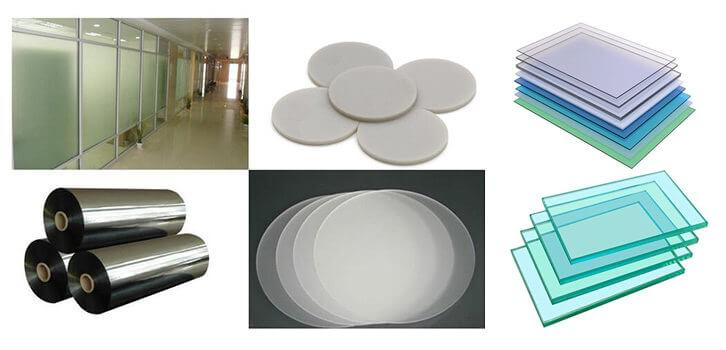
II. Linshang tint meter characteristics
1. Regular transparent material transmittance detection
PC board, transparent acrylic board, automobile windshield, PMMA, curtain wall glass, film and other regular transparent materials can be tested with handheld tint meter LS110 or LS116. Among them, it is easier and more convenient to test the installed glass with the split type tint meter LS110, such as the front and side windwhield of a car. For accuracy requirements, you can use the LS116 tint meter to test.
● The measurement accuracy is better than ± 2%, which can ensure to pass the Chinese national measurement.
● The main machine and the auxiliary machine are separated. The super strong magnetic force is automatically pulled together during the test.
● The measurement accuracy can reach ± 1%, which is the highest accuracy in the series.
● LS116 tint meter can test 99.8% of highly transparent samples with a resolution of up to 0.001%
2. Transmittance detection of other transparent materials
Light transmittance of materials such as lampshade, diffuser, black film, screen printing ink for mobile phone cover, aluminized film, opalescent, matte, matte, etc. can be tested with the tint meter LS117. The tint meter also displays the optical density value when testing the transmittance value.
● Use diffuse transmission principle, can replace the integrating sphere test method
III. Linshang tint meter video
Linshang split window tint meter LS110 is used to test the installed automobile glass. The curtain wall glass is very simple and convenient, suitable for use in traffic police brigade, car inspection station and other places.
1. How does LS110 tint meter works?
After the tint meter is turned on, when testing, put the main machine outside the car window and the auxiliary machine inside the car window, the tint meter will automatically close together.
Then the two red laser points on the top and bottom are aligned and the test data will be directly displayed on the interface.
ress the HOLD button to lock the test data. You can also view the test data after removing the tint meter.
Tint meter LS110, with high accuracy, is suitable for testing the light transmittance of uniform light transmitting materials. There are two methods of fixed base measurement and fixed-point measurement.
2. How to use the LS116 tint meter?
Fixed base measurement: Put the probe of the tint meter into the fixed base and it will show 100% when the tint meter is turned on. The test material is placed into the test slot and the test results are immediately displayed.
On-site measurement: Align the test probes of the tint meter and pull them in. After the display shows 100%, clamp the two objects under test. The test results will be displayed on the screen immediately.
IV. FAQ about tint meter
-
1. Calibration specification for visible tint meter
According to JJF1225-2009 " Calibration Specification For Transmittance Meter of Automobile", the standard stipulates that all tint meters must meet the requirements of the CIE photopic luminosity function standard. The International Commission on Illumination published the standard value of photopic luminosity function standard V (λ) on the basis of experimental data in 1971 and was approved by the International Metrology Commission in 1972.
The Linshang portable tint meters LS110 and LS116 use 380nm-760nm full-band white light as the light source, which conforms to the international CIE photopic luminosity function standard. It can pass the inspection of Chinese metrology.
-
2. Diffusion transmission principle
The tint meter LS117 uses the principle of diffuse transmission. The test procedures for light transmittance and optical density are as follows:
(1) Light transmittance verification procedures:
Verification basis: JJG178-2007 " Ultraviolet, Visible, Near-Infrared Spectrophotometers"
Verification description: When measuring the light transmittance, the LS117 has a mutual reflection between the milk glass and the sample (for details, see GB / T 11500-2008 / ISO 5-2 Photography-Density measurement), so the probe is received. The black flannel must be pasted for calibration.
(2) Optical density verification procedures:
Verification basis: JJG920-1996 "Diffusion Transmission Visual Densitometer "
Verification instructions: When the tint meter LS117 verifies the optical density, the receiving probe does not need to be attached with a black flannel. (The factory does not paste flannel)
-
3. What is the difference between the portable tint meter LS116 and the handheld tint meter LS110?
(1) Different appearance
The shape of the LS116 tint meter is a desktop design, with a cable and a fixed base, while the window tint meter LS110 is a split design, which is composed of the main machine and the auxiliary machine, without wires.
(2) Different accuracy
The accuracy of the tint meter LS116 is as high as ± 1%, while the measurement accuracy of the handheld tint meterLS110 is better than ± 2%.
(3) Different test method
The tint meter LS116 has two methods of fixed base measurement and on-site measurement, while the split type tint meter LS110 clamp the tested material for testing.
-
4. What is the difference between the tint meter LS116 and LS117?
(1) Different test materials
The tint meter LS116 is suitable for the light transmittance test of regular flat transparent materials. The materials must be transparent and must not be frosted or foggy, such as PC, film, plexiglass, etc.
The tint meter LS117 uses the diffuse transmission principle, which can measure both transparent materials and various light-transmitting matte, opalescent and misty materials. Such as lampshade, aluminized film, black film and other materials.
(2) Different design principles
The LS116 tint meter uses the regular transmission principle and the LS117tint meter uses the diffuse transmission test principle.
(3) Different test functions
The LS116 tint meter can only test the light transmittance and the measurement accuracy is ± 1%. The LS117 tint meter can test both light transmittance and optical density. Both test values are displayed at the same time. The measurement accuracy of light transmittance and optical density is also different.
-
5. Are there any differences between the transparent material data of the desktop tint meter LS116 and LS117 test rules?
The light sources of the tint meters LS117 and LS116 are both 380-760nm white light, which conforms to the CIE photopic luminosity function standard. When testing transparent materials, if the material is thin, the receiving surface of the LS117 tint meter is covered with flannel. The difference is relatively small, but when the tested material is thicker, the data difference will be larger. This is because the tint meter LS117 uses a point light source, while the tint meter LS116 uses parallel light path design.
-
6. Are there any differences in the data of the opalescent materials measured by the tint meters LS116 and LS117?
Yes, this is because when the light passes through the opalescent material, the transmitted light will be scattered, which will cause the desktop tint meter LS116 to receive only part of the light. The measured data will be low and the data is inaccurate. The test with the tint meter LS117 with the integrating sphere effect fully meets the test requirements of diffuse transmission materials.
The above are the answers to the verification rules, calibration specifications and product applications of the Linshang portable tint meter. If you want to know more about the light transmittance measurement and the tint meter, you can visit the Linshang official website or consult engineers .
-
7. What is the difference between tint meter LS117 and haze meter with diffuse transmission principle?
The measurement is completely different two parameters, there is no comparability.
1. The haze meter measures is deviated from the incident light more than 2.5 ° angle of transmitted light intensity as a percentage of the total transmitted light intensity, the greater the haze means that the measured material gloss, transparency and imaging degree is worse.
2. Diffuse transmission principle of the tnt meter LS117 measurement is the transmission of all light intensity as a percentage of the original light intensity, is to measure the total light transmission of the material, the greater the light transmission means that the measured material light transmission performance is better
-
8. How to test the light transmission of smoke concentration?
You can use the LS116 tint meter. First turn on the instrument without placing any test material, and after the instrument passes self-calibration, put the probe and detector with the base into the smoke box (or other smoke filled container) to test the smoke transmittance.
-
9. How to distinguish between transparent and translucent materials?
You can put the sample in front of your eyes and look at the object through the sample, if the edges are clear, it is a fully transparent material. If the edges are fuzzy and a little blurry, it is a foggy material.
-
10. Why do I need to paste fleece when LS117 tests highly transparent materials?
Because the light will be reflected between the opal glass and the sample at the receiver end, resulting in the transmittance value will be large. For materials with actual transmittance values greater than 96%, the test value may show 100%. When testing very high transmittance materials, it is recommended to apply fleece to reduce the reflective area at the receiver end.
- Linshang Insulated Glass Unit Measuring Tools
- Spectacle lens anti-blue light detection---blue-violet light transmittance meter
- Measurement of Optical Density
- Difference of LS116 Transmission & LS117 OD Meter
- Difference between LS116 and LS117 Light Transmittance Meter
- What’s the Difference Between Point Light and Parallel Light Transmittance Meter
